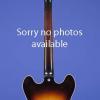A Really White 1962 'Olympic White' Jaguar!
This 13 3/4-inch-wide Jaguar weighs 8.00 lbs. and has a "B" nut width of just under 1 5/8 inches and a scale length of 24 inches. Solid alder body, one-piece maple neck with a nice medium-to-thin profile and a curved veneer rosewood fretboard with 22 original frets and inlaid clay dot position markers. Headstock with matching "Olympic White" finish and decal with "Fender" logo in gold with black trim, "Jaguar" in black beside it, and four patent numbers in black below. "Offset Contour Body" decal at the ball end of the headstock. Single "butterfly" string tree. The neck is stamped "1 SEP 62B." Four-bolt neck plate with serial number ("82354") between the top two screws. Individual single-line Kluson Deluxe tuners with oval metal buttons. Two white oblong Strat-like pickups with notched metal side plates and outputs of 7.85k and 6.64k. Four-layer tortoiseshell over white, black & white plastic pickguard with ten screws. Two controls (one volume, one tone) and jack socket on lower metal plate adjoining pickguard on the treble side, circuit selector (rhythm/lead) slide switch and two roller controls (one volume, one tone) on upper metal plate adjoining pickguard on the bass side, and three pickup selector slide switches on metal plate inset into the pickguard on the treble side. The potentiometers are stamped "304 6152" and "304 6236" (Stackpole, December 1961 and September 1962). Black plastic Jaguar knobs with white markings. Jazzmaster-type floating tremolo and bridge with adjustable mute. Complete with the original tremolo arm and bridge cover. This guitar is in exceptionally fine (9.00) condition, with minimal belt buckle scarring on the back, some light finish checking and a few very small chips or marks on the edges. A fabulous example, one of the very few guitars of that era that escaped from the factory without the nitrocellulose clear coat and has therefore actually remained white. Housed in a later Fender G & L black hardshell case with black plush lining (9.50).
In mid 1962 Fender introduced its most expensive "top-of-the-line" guitar called the Jaguar. The Jaguar’s pickups are more powerful and better shielded, which eliminated some of the hum problems associated with the Jazzmaster. The shorter (24 inch) scale was favored by some guitarists at that time, especially the surf music players. The Jaguar shared its unique rhythm circuit with the Jazzmaster. This allowed a pre-set tone for rhythm playing.
"Not content with the relatively expensive Jazzmaster, Fender introduced a new top-of-the-line model in 1962: the Jaguar. [The pricelist offered a basic Sunburst Jaguar at $379.50; a similar Jazzmaster was $349.50]. Another offset-waist multi-control instrument, the Jag seemed an attractive proposition, but still failed to dent the supremacy of Fender's dynamic duo, the Tele and the Strat...The Jag used a similar offset-waist body shape to the earlier Jazzmaster, and also shared that guitar's separate bridge and vibrato unit, although the Jaguar had the addition of a spring-loaded string mute at the bridge. Fender rather optimistically believed that players would prefer a mechanical string mute to the natural edge-of-the-hand method. They did not. There were some notable differences between the Jaguar and Jazzmaster. Visually, the Jag had distinctive chromed control panels, and was the first Fender with 22 frets. Its 24" (610mm) scale-length ('faster, more comfortable') was shorter than the Fender standard of 25" (635mm) and closer to that of Gibson. It gave the Jag a different playing feel compared to other Fenders. The Jaguar had better pickups than the Jazzmaster. They looked much like Strat units but had metal shielding added at the base and sides, no doubt as a response to the criticisms of the Jazzmaster's tendency to noisiness. The Jag's electrics were yet more complex than the Jazzmaster's, using the same rhythm circuit but adding a trio of lead-circuit switches...The Jaguar was offered from the start in four different neck widths, one a size narrower and two wider than normal (coded A, B, C or D, from narrowest to widest, with 'normal' B the most common)" (Tony Bacon, 50 Years of Fender, p. 36).
"Fender used only nitrocellulose paint." What Fender really did was use the colors as available from DuPont, be it acrylic or nitrocellulose. But they nearly always used clear lacquer that was nitrocellulose based. Unfortunately, the clear nitrocellulose lacquer yellowed significantly. This distorted the shade of many colors, especially blue, silver, green and white. On the positive side, the nitrocellulose clear coat softened the color, making it look warmer and less sharp. The cause of the yellowing clear nitrocellulose lacquer is largely, but not entirely, environmental. Ultraviolet (UV) light from the sun or fluorescent lights will accelerate the process. Air quality problems (smoking, smog) can also contribute significantly. But the nature of the lacquer beast is that nitrocellulose clear will yellow, to some degree, no matter how the instrument is stored.
However (and fortunately for us) in the early sixties Fender did not always use clear nitrocellulose lacquer coats on some custom colors and this fully original 1962 Olympic White Jaguar is a prime example of an instrument that was not clear coated. How do we know? No yellowing of the finish!
Translate:


